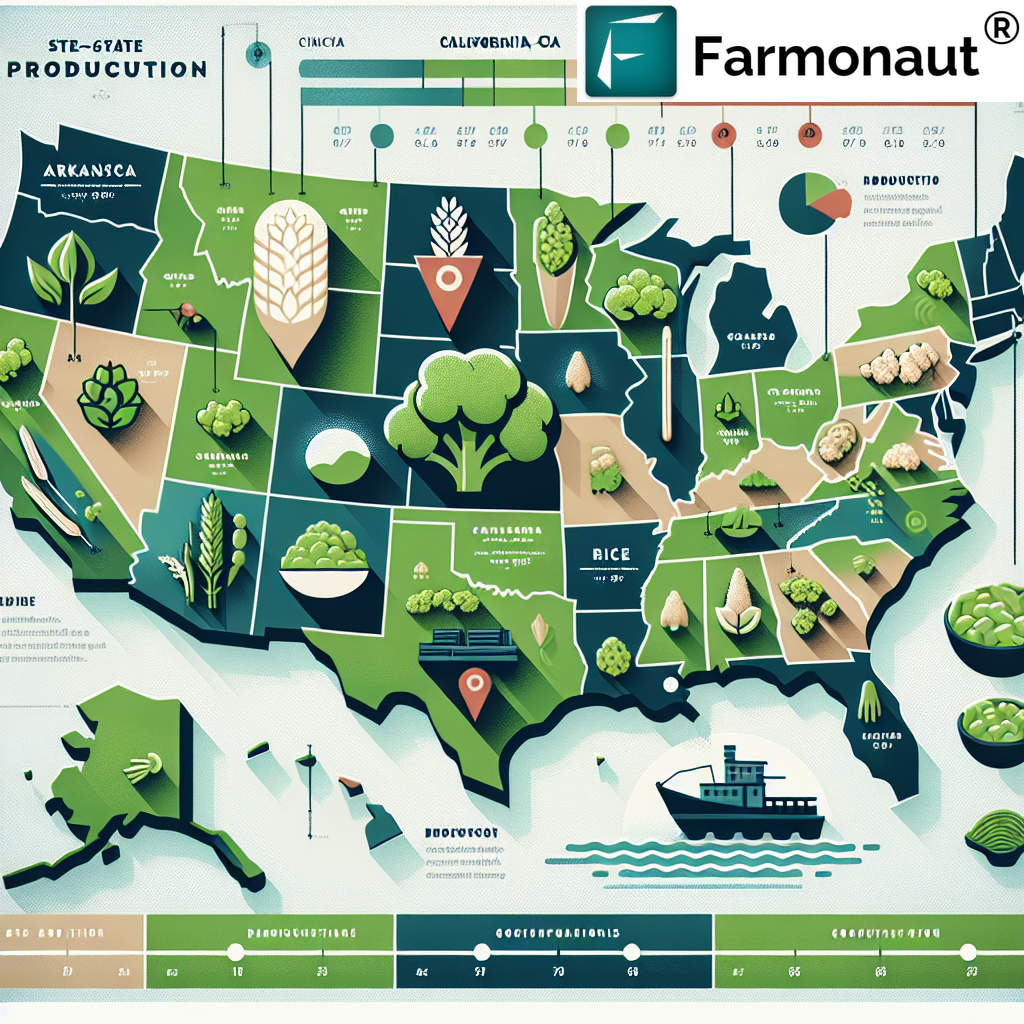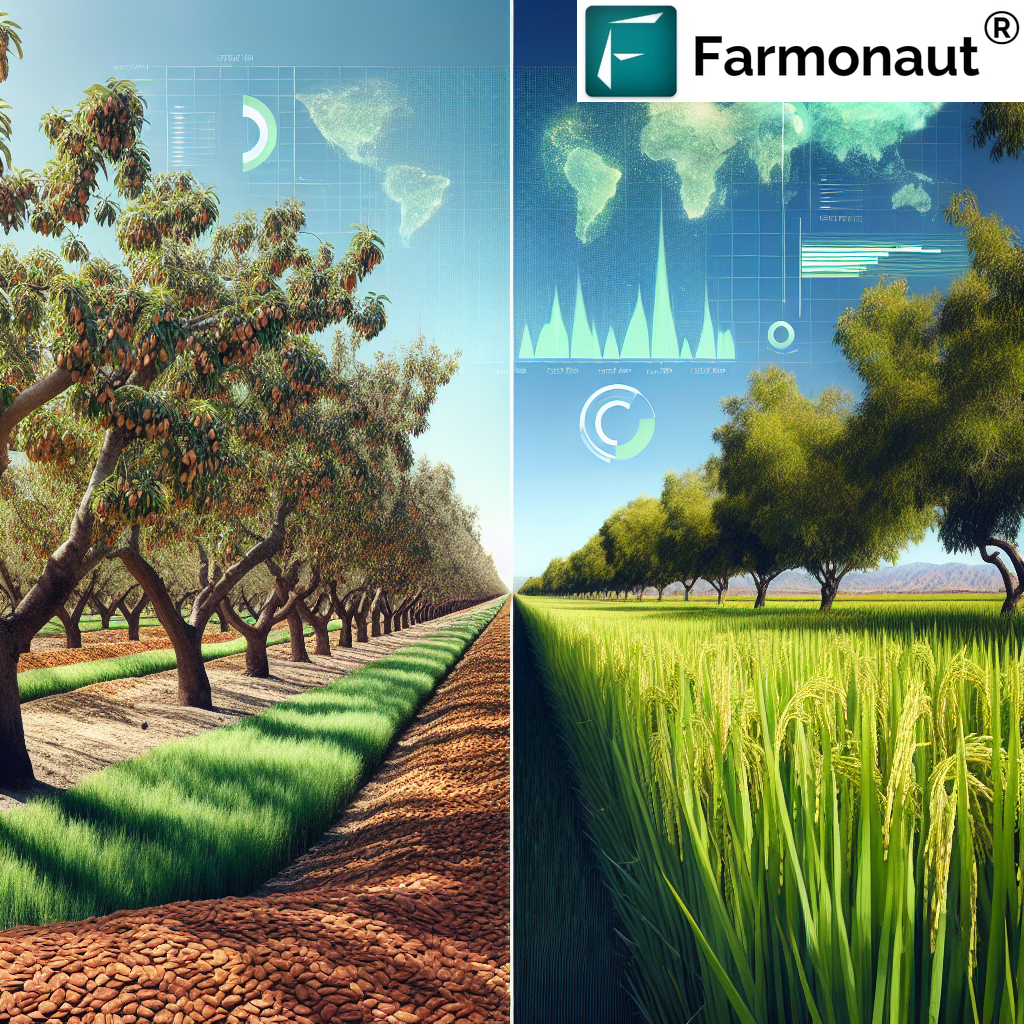
State-by-State Crop Production Analysis: From California Almonds to Bihar Rice
In the ever-evolving landscape of global agriculture, understanding the intricacies of crop production across different regions is crucial for farmers, policymakers, and agribusinesses alike. At Farmonaut, we’re committed to providing cutting-edge solutions that empower stakeholders in the agricultural sector with valuable insights and data-driven decision-making tools. In this comprehensive blog post, we’ll delve into the fascinating world of state-by-state crop production, focusing on key agricultural powerhouses and their signature crops.
The Importance of Regional Crop Analysis
Before we dive into the specifics of various states and their agricultural outputs, it’s essential to understand why regional crop analysis matters. In an era of climate change, evolving consumer preferences, and global market fluctuations, having a granular understanding of crop production patterns can:
- Inform agricultural policy decisions
- Guide farmers in crop selection and rotation
- Help agribusinesses optimize their supply chains
- Assist in predicting market trends and pricing
- Support sustainable farming practices
At Farmonaut, we leverage advanced satellite technology and AI-driven analytics to provide real-time insights into crop health, soil conditions, and weather patterns. This technology is pivotal in understanding and optimizing crop production across diverse geographical regions.
California: The Almond Capital of the World
When it comes to California almond production, the Golden State stands head and shoulders above the rest. California is not just a leader in almond production within the United States; it’s the world’s largest producer of almonds, accounting for approximately 80% of the global supply.
Key Facts about California Almond Production:
- Over 1.5 million acres dedicated to almond orchards
- Annual production exceeding 2 billion pounds of almonds
- Contributes significantly to California’s agricultural economy, with exports valued at over $4 billion annually
- Employs over 100,000 people in the almond industry
The success of California’s almond industry can be attributed to several factors:
- Ideal Climate: The Mediterranean climate of California’s Central Valley provides perfect conditions for almond trees to thrive.
- Advanced Farming Techniques: California farmers employ state-of-the-art irrigation systems and precision agriculture methods to maximize yields.
- Research and Development: Ongoing research into almond varieties and farming practices continually improves productivity and sustainability.
- Strong Industry Support: Organizations like the Almond Board of California provide crucial support and marketing efforts.
At Farmonaut, we recognize the importance of precision agriculture in maximizing almond production. Our satellite-based crop health monitoring system helps almond growers in California optimize their irrigation strategies, detect pest infestations early, and make data-driven decisions to improve yield and quality.
Arkansas: The Rice Bowl of America
When we talk about rice production in Arkansas, we’re discussing one of the most significant rice-growing regions in the United States. Arkansas leads the nation in rice production, contributing substantially to both domestic consumption and exports.
Key Facts about Rice Production in Arkansas:
- Over 1.4 million acres dedicated to rice cultivation
- Produces approximately 50% of all rice grown in the United States
- Annual production often exceeding 100 million hundredweight (cwt) of rice
- Contributes billions of dollars to the state’s economy
Several factors contribute to Arkansas’s dominance in rice production:
- Ideal Growing Conditions: The state’s flat terrain, clay soils, and abundant water resources are perfect for rice cultivation.
- Advanced Infrastructure: Arkansas has developed extensive irrigation systems and milling facilities to support rice production.
- Research and Innovation: The University of Arkansas System Division of Agriculture conducts ongoing research to improve rice varieties and farming practices.
- Skilled Workforce: Generations of farmers have honed their expertise in rice cultivation, passing down knowledge and techniques.
At Farmonaut, we understand the unique challenges faced by rice farmers in Arkansas. Our satellite-based monitoring system helps farmers track field conditions, optimize water management, and detect potential issues like pest infestations or nutrient deficiencies. By providing real-time data and actionable insights, we empower rice farmers to make informed decisions that can significantly impact their yields and profitability.
Bihar: India’s Emerging Rice Powerhouse
Shifting our focus to the international stage, let’s examine rice production in Bihar, one of India’s most important agricultural states. Bihar has been making significant strides in rice cultivation, emerging as a key player in India’s rice production landscape.
Key Facts about Rice Production in Bihar:
- Over 3.3 million hectares under rice cultivation
- Annual production exceeding 8 million metric tons of rice
- Contributes significantly to India’s food security
- Employs a large portion of the state’s agricultural workforce
Bihar’s success in rice production can be attributed to several factors:
- Fertile Soil: The Gangetic plains of Bihar provide rich, alluvial soil ideal for rice cultivation.
- Abundant Water Resources: The state benefits from numerous rivers and a good monsoon season, essential for rice farming.
- Government Support: Various initiatives and subsidies encourage farmers to adopt modern farming techniques and high-yielding varieties.
- Improved Infrastructure: Investments in irrigation systems and rural electrification have boosted agricultural productivity.
At Farmonaut, we’re excited about the potential of technology to further enhance rice production in Bihar. Our satellite-based crop monitoring system can be particularly beneficial in a region where small and marginal farmers dominate. By providing affordable access to precision agriculture tools, we can help Bihar’s rice farmers optimize their resource use, improve crop health, and increase yields.
Broccoli Production by State: A Diverse Landscape
While not as concentrated as almond or rice production, broccoli production by state in the United States presents an interesting and diverse agricultural landscape. Several states contribute significantly to the nation’s broccoli output, each with its unique growing conditions and challenges.
Top Broccoli-Producing States:
- California: Leads the nation in broccoli production, accounting for over 90% of the U.S. crop.
- Arizona: Second-largest producer, particularly important for winter harvests.
- Oregon: Known for high-quality broccoli production in the cooler climate of the Pacific Northwest.
- Maine: Emerging as a significant producer, especially for fresh market broccoli.
- New York: Contributes to the nation’s broccoli supply, particularly for local and regional markets.
Key Factors Influencing Broccoli Production:
- Climate: Broccoli thrives in cool temperatures, making coastal and higher elevation areas ideal for cultivation.
- Water Availability: Adequate irrigation is crucial for broccoli production, influencing where it can be grown successfully.
- Market Proximity: Fresh broccoli’s perishability makes proximity to major markets an important factor in production locations.
- Labor Availability: Broccoli harvesting is labor-intensive, making access to a skilled workforce essential.
At Farmonaut, we recognize the unique challenges faced by broccoli growers across different states. Our satellite-based crop monitoring system can be particularly valuable in helping farmers optimize their broccoli production, regardless of their location. By providing real-time data on crop health, soil moisture, and potential pest issues, we empower farmers to make informed decisions that can significantly impact their yields and profitability.
The Role of Technology in Modern Agriculture
As we’ve explored the diverse landscape of crop production across different states and countries, it’s clear that technology plays an increasingly crucial role in modern agriculture. At Farmonaut, we’re at the forefront of this technological revolution, offering innovative solutions that help farmers, agribusinesses, and policymakers make data-driven decisions.
How Farmonaut’s Satellite System Revolutionizes Farm Monitoring
Our satellite-based farm monitoring system offers several advantages over traditional methods like drone and IoT-based monitoring. Here’s a comparison:
| Feature | Farmonaut Satellite System | Drone-based Monitoring | IoT-based Monitoring |
|---|---|---|---|
| Coverage Area | Large scale (thousands of acres) | Limited (depends on flight time) | Limited (depends on sensor placement) |
| Data Frequency | Regular updates (every 3-5 days) | On-demand (requires manual flights) | Continuous (but limited to sensor locations) |
| Initial Setup Cost | Low (no hardware required) | High (drone purchase and training) | Medium to High (sensor network setup) |
| Operational Complexity | Low (cloud-based system) | High (requires trained operators) | Medium (maintenance of sensor network) |
| Weather Independence | High (can penetrate clouds) | Low (affected by wind and rain) | Medium (some sensors weather-sensitive) |
| Scalability | Highly scalable | Limited by equipment and manpower | Scalable but requires additional hardware |
Our satellite-based system offers unparalleled coverage, cost-effectiveness, and ease of use, making it an ideal solution for farmers and agribusinesses of all sizes.
Farmonaut’s Comprehensive Agricultural Solutions
At Farmonaut, we offer a suite of tools designed to address the diverse needs of the agricultural sector:
- Satellite-Based Crop Health Monitoring: Our advanced system provides real-time insights into vegetation health, soil moisture levels, and other critical metrics. Try our app to experience the power of satellite-based monitoring firsthand.
- Jeevn AI Advisory System: Our AI-driven tool delivers personalized farm advice, weather forecasts, and expert crop management strategies.
- Blockchain-Based Product Traceability: We ensure transparency and security in agricultural supply chains, from farm to consumer.
- Fleet and Resource Management: Our tools help agribusinesses optimize their logistics and reduce operational costs.
- Carbon Footprinting: We assist businesses in monitoring and reducing their environmental impact, promoting sustainable agriculture.
For developers and businesses looking to integrate our powerful satellite and weather data into their own systems, we offer comprehensive API access. Check out our API documentation to learn more.
Empowering Farmers Worldwide
Whether you’re an almond grower in California, a rice farmer in Arkansas or Bihar, or a broccoli producer anywhere in the United States, Farmonaut’s solutions are designed to help you optimize your operations and increase profitability. Our platform is accessible through both web and mobile apps, making it easy to track and manage your farms from anywhere.
Download our app today:
For more advanced users and developers, explore our Satellite Weather API Developer Docs to integrate our powerful data into your own applications.
Join the Agricultural Revolution with Farmonaut
As we’ve explored the diverse landscape of crop production across different states and countries, it’s clear that the future of agriculture lies in the integration of advanced technology with traditional farming practices. At Farmonaut, we’re committed to making this future a reality for farmers worldwide.
Ready to transform your farming practices? Subscribe to Farmonaut today and join the agricultural revolution:
Frequently Asked Questions (FAQs)
-
Q: How does Farmonaut’s satellite monitoring system work?
A: Our system uses multispectral satellite images to monitor crop health, providing insights into vegetation health, soil moisture levels, and other critical metrics. This data is processed using AI and machine learning algorithms to deliver actionable insights to farmers. -
Q: Can Farmonaut’s solutions be used for all types of crops?
A: Yes, our satellite-based monitoring system is versatile and can be used for a wide range of crops, including almonds, rice, broccoli, and many others. The system adapts to the specific characteristics of each crop type. -
Q: How often is satellite data updated?
A: Our satellite data is typically updated every 3-5 days, providing regular insights into crop health and field conditions. -
Q: Is Farmonaut’s system suitable for small-scale farmers?
A: Absolutely! We’ve designed our system to be accessible and affordable for farmers of all scales, from small family farms to large agricultural enterprises. -
Q: How can Farmonaut help improve crop yields?
A: By providing real-time data on crop health, soil conditions, and potential issues like pest infestations, Farmonaut empowers farmers to make timely, informed decisions that can significantly improve crop yields and quality.
In conclusion, as we navigate the complexities of modern agriculture, from California’s almond orchards to Bihar’s rice fields, the role of technology in optimizing crop production becomes increasingly evident. At Farmonaut, we’re proud to be at the forefront of this agricultural revolution, providing innovative solutions that empower farmers, improve productivity, and promote sustainable practices worldwide.














